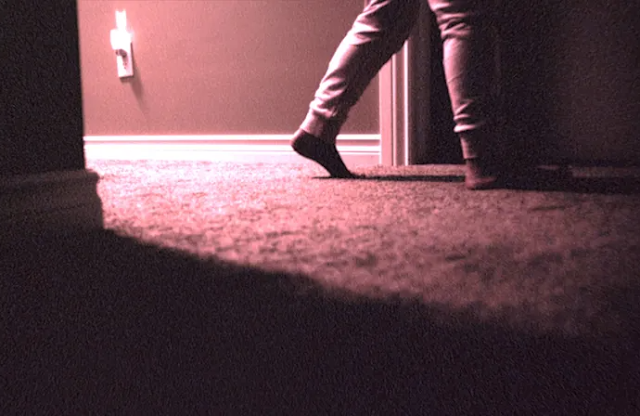- Get link
- X
- Other Apps
- Get link
- X
- Other Apps

Skinamarink earns the title of most confounding horror movie I've ever seen. What you will see can hardly be called a story. Tapping in at 100 minutes – with only ten of those devoted to seeing characters on screen – this experimental film written and directed by Kyle Edward Ball forces viewers into a deeply unsettling and uncomfortable space. This very element of space allows viewers to summon a nightmare of their own choosing, making Skinamarink a choose-your-own-adventure horror.
The movie takes place inside one home late at night. Two children wake up and do what children do at night. They seek comfort in things that seem safe. When they can't find their parents, they huddle close together and draw near to the promised bubble of protection offered by the light and warmth of the television screen. They occupy their hands with the innocent childhood ritual of coloring with crayons on paper.
But still, unnamed and unseen evil lingers near. If "Show, don't tell" is the writer's golden rule, Ball takes that precept to a new extreme. We see only impressions of what the twins are up to by witnessing objects in the rooms of the house. A creaky closet opens, and a hand pulls a blanket off the top shelf, knocking extra linens to the ground. We then see one angle of a staircase. Then another. With the house shrouded in darkness, we can't be sure exactly what we are looking at. We hear a large object falling down a staircase; then a voice cries from far away. An adult picks up a phone and reports coming back from the hospital. The director cuts between these shorts roughly, often interrupting the little dialogue that takes place.

Other times, the camera spends unhurried stretches of time in one spot, looking under a bed, staring at a wall, or dwelling on a television screen. The camera's lens stays mostly in a tight zoomed-in view. We see only portions of things, presenting the illusion of closeness. Our closeness puts us in the perspective of one of the characters, and it's downright uncomfortable. Modern audiences usually enjoy the privilege of voyeurism. We get to watch other people handle different situations – whether sweet, sad, frustrating, or nightmarish. We get to be the judge of what we see.
The horror and thriller genres, more than any other, messes with this formula of observing characters from afar. Usually that shift only lasts a short time. The change only lasts for a moment in Psycho, when we become Norman Bates, peeking at Marion Crane through the peephole. It lasts longer in Strange Days, when, twice in one movie, we observe two women get assaulted from the assaulter's perspective – brutal but memorable scenes. But very few directors keep viewers there long because of the toll it takes.
This prolonged state of disembodiment will cause many viewers to disengage with the narrative. But I found the experience provocative and unsettling. Free from a prescribed narrative, I became immersed in feeling what it would be like to be one of those twins. Skinamarink forces you into that time in childhood when you felt unsafe in your own home. With no comfort offered from mom and dad, you try to create a scaffold of safety, praying for the light to come. You make up rituals to distract from the paralyzing fear that something is coming.
"Insert fear here." What exactly plagues these young twins? Has an intruder come to the house to torture the children? Have demons come to roost? Are the parents the true villains, abusing their children? The evil remains unresolved, which may allow Skinamarink to haunt me until the end of my days.
Besides the lack of narrative, viewers may also despair at the sound levels of the film. For one of the first times in my career, I recommend Skinamarink be watched at home when you can enjoy captions and volume control. The characters whisper so much that captions do appear in some parts of the film by default. But not in every case. The low sound level forces you to lean in to hear better and heightens the suspense. The film is purposefully distressed to mimic the vintage quality of 1970s film strips. While this makes the images hard to see, it also adds to the disorientation you feel as you try to make sense of the sights and sounds around you in a dark house.
In early 2022, Ricky D'Ambrose released The Cathedral. Afterward, I announced that Ricky D'Ambrose had birthed a new style in filmmaking, that of movies that function like collages. We dwell on objects in the room rather than the people in those rooms. We take snapshots of the space. With Skinamarink, Ball creates a horror version of the same concept. With such a new style, Skinamarink will not be for everyone, but for the patient, there is terror to be found.
Recommended for: Fans of experimental horror and cinema which pushes the boundaries of the art form. Your mileage may vary.
Release info: Skinamarink is now playing in some theater; will move to Shudder on February 2, 2023
Final score: 4 out of 5
.jpg)


Comments